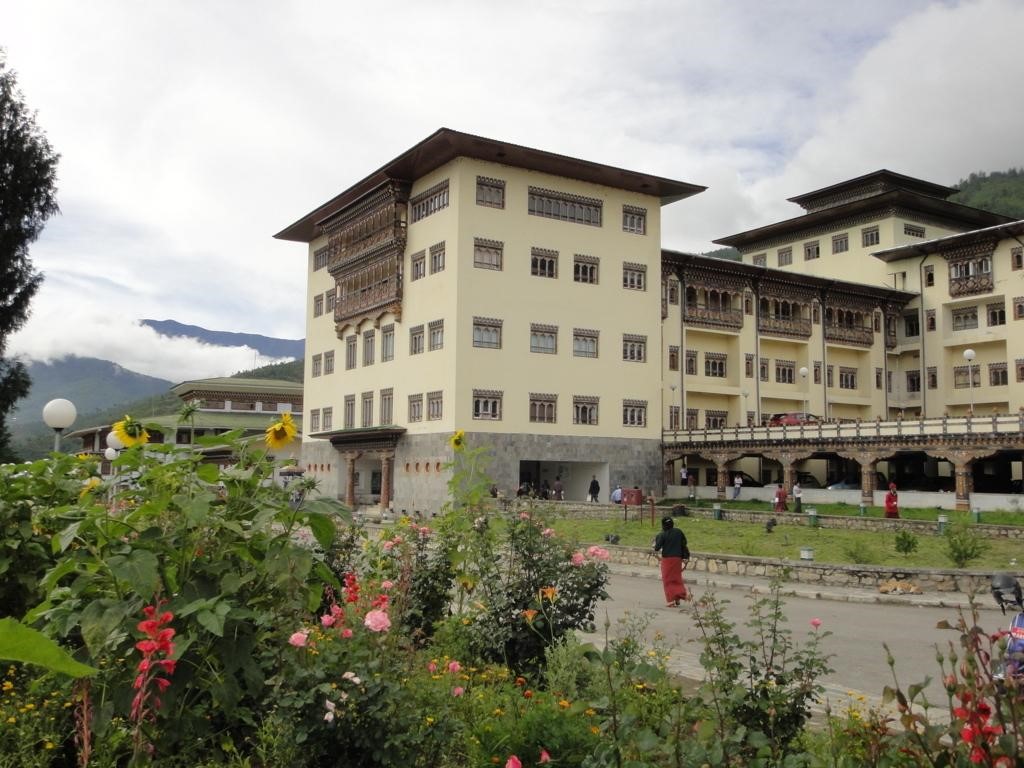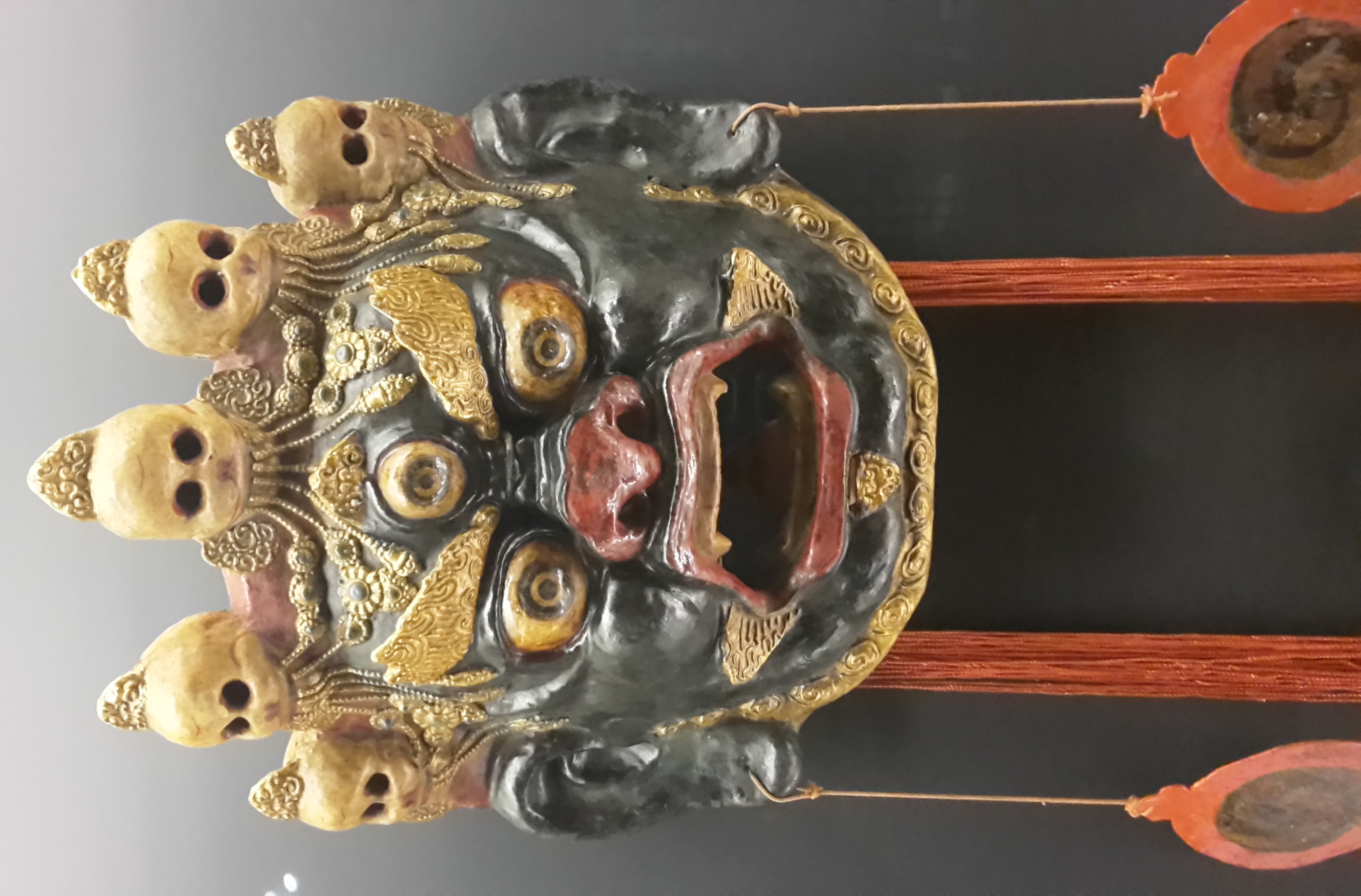|
Changangkha Lhakhang
Changangkha Lhakhang is a compact temple complex located on the tip of a ridge that juts towards central Thimphu from the hills to the east. Founded in the 13th or 14th centuries, it is probably the oldest surviving temple in Thimphu. The main components and foundations of the monastery are extremely old, long predating the unification of Bhutan in the 17th century by Ngawang Namgyal , Zhabdrung Ngawang Namgyal. The temple is often frequented by parents with small children seeking to obtain blessings from the protective deity of the temple, Genyen Domtsangpa, who is considered to be the birth deity and protector of children born in Jigme Dorji Wangchuck National Referral Hospital , JDWNRH national referral hospital in Thimphu. History Changangkha Lhakhang was founded in the 13th C by Nyima, one of the sons of Phajo Drugom Zhigpo who first introduced the teachings of the Drukpa Kagyu tradition of Himalayan Buddhism to Bhutan, and who is revered as an emanation of Avalokiteśvar ... [...More Info...] [...Related Items...] OR: [Wikipedia] [Google] [Baidu] |
Ngawang Namgyal
Ngawang Namgyal (later granted the honorific Zhabdrung Rinpoche, approximately "at whose feet one submits") (; alternate spellings include ''Zhabdrung Ngawang Namgyel''; 1594–1651) and known colloquially as The Bearded Lama, was a Tibetan Buddhism, Tibetan Buddhist ''lama'' and the unifier of Bhutan as a nation-state. In addition to unifying the various warring fiefdoms for the first time in the 1630s, he also sought to create a distinct culture of Bhutan, Bhutanese cultural identity separate from the Tibetan culture from which it was derived. Birth and enthronement at Ralung ''Zhabdrung'' Ngawang Namgyal was born at Ralung Monastery, Ralung () Monastery, Tibet as the son of the Drukpa Lineage, Drukpa lineage-holder Mipham Tenpa'i Nyima (, 1567–1619), and Sönam Pelgyi Butri (), daughter of the ruler of Kyishö () in Tibet. On his father's side, Ngawang Namgyal descended from the family line of Tsangpa Gyare (1161–1211), the founder of the Drukpa Lineage. In his youth, Ng ... [...More Info...] [...Related Items...] OR: [Wikipedia] [Google] [Baidu] |
Jigme Dorji Wangchuck National Referral Hospital
The National Referral Hospital (full name ''Jigme Dorji Wangchuck National Referral Hospital'') is the main hospital of Bhutan, located in the capital of Bhutan, Thimphu. Since it was established in 1972, the hospital has been supplying free basic medical treatment as well as advanced surgeries and emergency services to citizens from all over the country. It provides the most sophisticated health evaluation and management services in the country. Recently the hospital has added CT and MRI diagnosis equipment and improved lab services. The hospital has a library with many current textbooks. The hospital is one of five medical service centers within Thimphu. There are two more hospitals, one is the Military Hospital, Lungtenphu managed by the Royal Bhutan Army and the other one is Indo-Bhutan Friendship hospital in the main town of Thimphu, managed by the Indian Military Training Team (IMTRAT). There is a Basic Health Unit (BHU) at Dechencholing and an Outreach Clinic in Motith ... [...More Info...] [...Related Items...] OR: [Wikipedia] [Google] [Baidu] |
Phajo Drugom Zhigpo
Phajo Drugom Shigpo () 184−1251 / 1208−1275was a Tibetan Buddhist particularly important in the early spread of the Drukpa school to Bhutan where he is revered as an emanation of Avalokiteśvara. His descendants played a significant role in the history of Bhutan. The ''Sacred Sites associated with Phajo Drugom Zhigpo and his descendants'' is listed as a tentative site in Bhutan's Tentative List for UNESCO inclusion. Biography Early life Just before he died, the founder of the Drukpa school, Tsangpa Gyare Yeshe Dorje told his nephew and heir, Onre Darma Senge (1177–1237), "A Khampa son from Kham is coming. But he won't meet me. You look after him. Send him to the southern valley that has been visited and blessed by Orgyen Padma Jungne. He will be of great service to the Buddha Dharma." Phajo Drugom Zhigpo was born, probably in 1184, at Yangtse Babchu ''(ryang tse 'bab chu)'', Tashigang in the Do-Kham region of East Tibet the youngest of three sons of the merchant Dabzan ... [...More Info...] [...Related Items...] OR: [Wikipedia] [Google] [Baidu] |
Drukpa Kagyu
The Drukpa Kagyu (), or simply Drukpa, sometimes called either Dugpa or "Red Hat sect" in older sources,Initiations And Initiates In Tibet, p. 34 by Alexandra David-Néel. lineage is a branch of the Kagyu school of . The Kagyu school is one of the Sarma or "New Translation" sc ... [...More Info...] [...Related Items...] OR: [Wikipedia] [Google] [Baidu] |
Himalayan Buddhism
Tibetan Buddhism (also referred to as Indo-Tibetan Buddhism, Lamaism, Lamaistic Buddhism, Himalayan Buddhism, and Northern Buddhism) is the form of Buddhism practiced in Tibet and Bhutan, where it is the dominant religion. It is also in majority regions surrounding the Himalayan areas of India (such as Ladakh, Sikkim, Arunachal Pradesh, and a minority in Himachal Pradesh and Uttarakhand), in much of Central Asia, in the southern Siberian regions such as Tuva, and in Mongolia. Tibetan Buddhism evolved as a form of Mahāyāna Buddhism stemming from the latest stages of Indian Buddhism (which also included many Vajrayāna elements). It thus preserves many Indian Buddhist tantric practices of the post-Gupta early medieval period (500 to 1200 CE), along with numerous native Tibetan developments. In the pre-modern era, Tibetan Buddhism spread outside of Tibet primarily due to the influence of the Mongol Yuan dynasty (1271–1368), founded by Kublai Khan, which had ruled China, ... [...More Info...] [...Related Items...] OR: [Wikipedia] [Google] [Baidu] |
Avalokiteśvara
In Buddhism, Avalokiteśvara (Sanskrit: अवलोकितेश्वर, IPA: ) is a bodhisattva who embodies the compassion of all Buddhas. He has 108 avatars, one notable avatar being Padmapāṇi (lotus bearer). He is variably depicted, described, and portrayed in different cultures as either male or female. In East Asian Buddhism, he has evolved into a female form called Guanyin. Etymology The name ''Avalokiteśvara'' combines the verbal prefix ''ava'' "down", ''lokita'', a past participle of the verb ''lok'' "to notice, behold, observe", here used in an active sense; and finally '' īśvara'', "lord", "ruler", "sovereign" or "master". In accordance with sandhi (Sanskrit rules of sound combination), ''a''+''īśvara'' becomes ''eśvara''. Combined, the parts mean "lord who gazes down (at the world)". The word ''loka'' ("world") is absent from the name, but the phrase is implied. It does appear in the Cambodian form of the name, ''Lokesvarak''. The earliest translation ... [...More Info...] [...Related Items...] OR: [Wikipedia] [Google] [Baidu] |
Dharmapala
A ''dharmapāla'' (, , ja, 達磨波羅, 護法善神, 護法神, 諸天善神, 諸天鬼神, 諸天善神諸大眷屬) is a type of wrathful god in Buddhism. The name means "''dharma'' protector" in Sanskrit, and the ''dharmapālas'' are also known as the Defenders of the Justice (Dharma), or the Guardians of the Law. There are two kinds of ''dharmapala'', Worldly Guardians (''lokapala'') and Wisdom Protectors (''jnanapala''). Only Wisdom Protectors are enlightened beings. Description A protector of Buddhist dharma is called a ''dharmapala''. They are typically wrathful deities, depicted with terrifying iconography in the Mahayana and tantric traditions of Buddhism. The wrathfulness is intended to depict their willingness to defend and guard Buddhist followers from dangers and enemies. The '' Aṣṭagatyaḥ'' (the eight kinds of nonhuman beings) is one category of ''dharmapālas'', which includes the Garuda, Deva, Naga, Yaksha, Gandharva, Asura, Kinnara and Mahoraga. In ... [...More Info...] [...Related Items...] OR: [Wikipedia] [Google] [Baidu] |
Stupa
A stupa ( sa, स्तूप, lit=heap, ) is a mound-like or hemispherical structure containing relics (such as ''śarīra'' – typically the remains of Buddhist monks or nuns) that is used as a place of meditation. In Buddhism, circumambulation or ''pradakhshina'' has been an important ritual and devotional practice since the earliest times, and stupas always have a ''pradakhshina'' path around them. The original South Asian form is a large solid dome above a tholobate or drum with vertical sides, which usually sits on a square base. There is no access to the inside of the structure. In large stupas there may be walkways for circumambulation on top of the base as well as on the ground below it. Large stupas have or had ''vedikā'' railings outside the path around the base, often highly decorated with sculpture, especially at the torana gateways, of which there are usually four. At the top of the dome is a thin vertical element, with one of more horizontal discs spreadin ... [...More Info...] [...Related Items...] OR: [Wikipedia] [Google] [Baidu] |
Tshechu
A tshechu ( dz, ཚེས་བཅུ།, literally "day ten") is any of the annual religious Bhutanese festivals held in each district or dzongkhag of Bhutan on the tenth day of a month of the lunar calendar, lunar Tibetan calendar. The month depends on the place. Tshechus are religious festivals of the Drukpa Lineage of the Kagyu school of Tibetan Buddhism. Tshechus are large social gatherings, which perform the function of social bonding among people of remote and spread-out villages. Large markets also congregate at the fair locations, leading to brisk commerce.Dancing on the demon's back: the dramnyen dance and song of Bhutan by Elaine Dobson, John Blacking Symposium: Music Culture and Society, Callaway Centre, University of Western Aust ... [...More Info...] [...Related Items...] OR: [Wikipedia] [Google] [Baidu] |
Phobjikha Valley
The Phobjikha Valley ཕོབ་སྦྱིས་ཁ spelled as Pho-sbis-kha, (the suffix ''kha'' is an element in many place-names in Bhutan and its use is generally optional both in colloquial speech and in literary forms) is a vast U-shaped valley in central Bhutan. The valley houses one of the impressive ancient Buddhist monasteries in Bhutan known as Gangteng Monastery of the Nyingma sect in central Bhutan. The graceful black-necked cranes in Bhutan (''Grus nigricollis'') from the Tibetan Plateau visit the valley during the winter season to roost. On arrival in the Phobjikha Valley in the last week of October, the black-necked cranes circle the Gangteng Monastery three times and also repeat the process while returning to Tibet. The broad valley with its best-known marshland in Bhutan, is popular for its scenic splendour and cultural uniqueness. The valley is rich in faunal biodiversity and has, apart from the globally threatened black-necked cranes ''Grus nigricollis'', 1 ... [...More Info...] [...Related Items...] OR: [Wikipedia] [Google] [Baidu] |
Drukpa Kagyu Monasteries And Temples In Bhutan
Druk ( dz, འབྲུག་) is the legendary Thunder Dragon of Bhutan. Druk may also refer to: Bhutan * Druk, of or pertaining to Bhutan :*of or pertaining to the Ngalop people, the majority ethnicity in Bhutan * Druk Gyalpo "Thunder Dragon King", the formal title of the King of Bhutan * Drukyul, the Dzongkha name for Bhutan, translates to ''Land of the Thunder Dragon'' * Druk tsendhen, the national anthem of Bhutan * Druk Air, the national airline of Bhutan * Druk Phuensum Tshogpa, the Bhutan Peace and Prosperity Party * Drukpa Kagyu, an independent branch of the Kagyu school of Tibetan Buddhism and the state religion of Bhutan ** Gyalwang Drukpa, the honorific title of the head of the Drukpa Lineage Other uses * Druk, a kind of small round Bohemian glass Bohemian glass, also referred to as Bohemia crystal, is glass produced in the regions of Bohemia and Silesia, now parts of the Czech Republic. It has a centuries long history of being internationally recognised for its h ... [...More Info...] [...Related Items...] OR: [Wikipedia] [Google] [Baidu] |

.jpeg/1200px-Tibetan_Buddhism_(214837929).jpeg)




